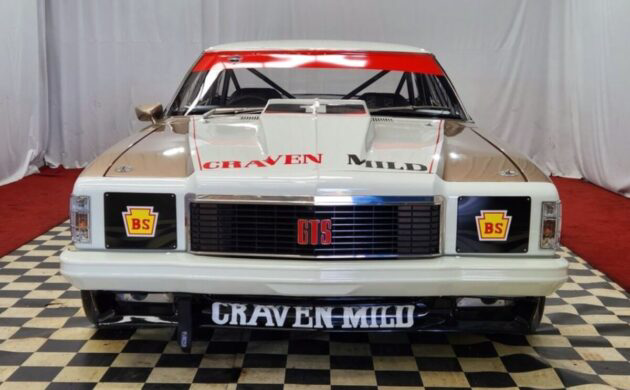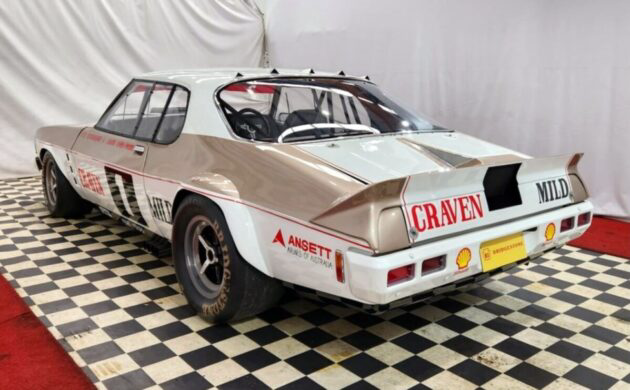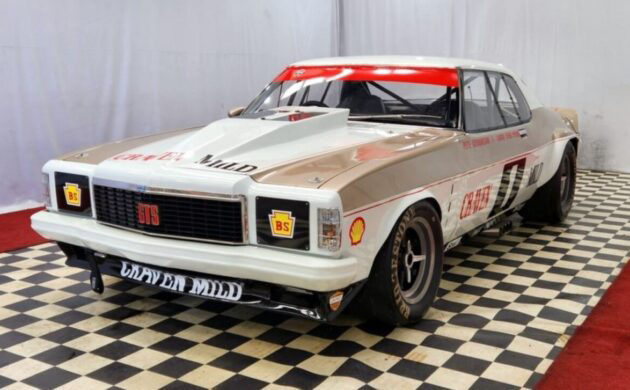We see the occasional Australian classic at Barn Finds, but it is a rare opportunity when three legendary vehicles appear in the same auction. I’ve been privileged to cover the other two, but the 1975 Holden Monaro Sports Sedan is no less significant. It was built to contest a big-bucks racing series and was driven by one of the sport’s larger-than-life characters. The Monaro spent years neglected but has been meticulously restored to its original form. It has remained part of a private collection but is set to go under the hammer here at Lloyds Auctioneers and Valuers. Online bidding has opened and rocketed to A$60,500 (US$41,000). The auction concludes on January 29th, and I expect the price to climb considerably before then.
Although Touring Car racing in various forms has been the staple of Australian motorsport for decades, there was a time during the 1970s when it faced stiff opposition from another category that threatened to steal its thunder. That category was Sports Sedans, which featured strange rules that produced incredible racing machinery. As the name suggests, it was restricted to closed vehicles. Although marques like Porsche were ineligible, it saw a curious mixture of cars like the VW Fastback and Alfa Romeo Alfetta competing against Mustangs, Toranas, Chevrolet Monzas, and, of course, Holden Monaros. The category rules were straightforward, with minor quirks that caused some owners to come unstuck. It allowed the cars to be lowered into the weeds, and suspension pickup points and configurations were free. Owners could add fiberglass panels, fender flares, and spoilers. However, panels like the roof and doors had to remain production components. Engines could be relocated, but the drivetrain configuration was expected to conform with the production version. It meant that if the vehicle originally featured an engine backed by a transmission that fed the power via a driveshaft to the rear end, that was what was expected of the new car. This saw some builders move engines and transmission into the cockpit, with an ultra-short driveshaft to the rear end. However, some competitors exploited a loophole in the rules, resulting in a Chevrolet Corvair featuring a mid-mounted small-block V8 hooked to a Hewland transaxle. That car complied with the letter of the law and went on to dominate the sport to the point where the administrators changed the rules, rendering it ineligible with the stroke of a pen. For all the freedoms, one inconsistency caught out some constructors. Cars were not limited to production engines, which is why the Corvair I mentioned featured a V8. A builder could install a V8 from any manufacturer, but the capacity limit was 5.0 liters. However, if you raced a car that was available with a larger engine, like a 1970 Mustang Mach 1, the limit rose to 6.0 liters. As we will see, this car’s original owner fell foul of that regulation.
Holden released its HJ Kingswood range in 1974. It was, essentially, an update of the previous HQ range. The new model brought some revised front and rear sheetmetal and a bolder grill design. The two-door Monaro remained part of the equation, as did a range of V8 engines. However, the company quietly dropped the imported Chevrolet 350ci small-block from the range, which had ramifications for this car. This Monaro commenced life as a production bodyshell, which was delivered to legendary designer, fabricator, and team manager, John Sheppard. Its owner wanted a car to compete in a couple of Sports Sedan Series that offered significant prize money. The lure of big dollars was hard to resist, and huge fields of V8 monsters drew spectators to the point where the category threatened the status of Touring Cars. Sheppard was and remains a design genius. He examined the Sports Sedan rules and determined that if everyone else were building a better mousetrap, he’d build a better mouse. He had seen constructors cut up cars to move engines as far back as possible and realized that approach could compromise structural rigidity. With this Monaro, he mounted the engine as low as possible but only moved it back until the front cylinders were barely behind the front axle centerline. This approach required minimal firewall cutting, maintaining the body’s strength. Most of the original Holden interior steel and floors remained intact, but the exterior received fender flares and spoilers to improve aerodynamic efficiency and to cover the enormous racing wheels and tires. The car passed through the hands of several owners during its life, with the current owner discovering it was heavily modified and missing crucial parts. They undertook a meticulous restoration, returning it to its original appearance and paint livery. The car presents superbly, looking as good today as it did when it scored its win on debut in 1975.
Lifting the Monaro’s hood reveals its beating heart and the reason it caused sharp words between its original owner and category scrutineers. John Sheppard equipped the car with a 350ci Chevrolet small-block, featuring racing internal components, Lucas fuel injection, dry sump lubrication, and Holden power steering. It is believed the engine pumped out more than 600hp, which fed to a Hewland transaxle. Spent gases exited the engine via tuned headers and an open exhaust, making this a loud beast. With a “money is no object approach,” Sheppard fabricated independent rear suspension, adding Ford GT40 hubs for the centerlock wheels. I previously mentioned the Sport Sedan engine capacity limits and Holden’s decision to drop the 350 from the HJ range. Category administrators deemed the car illegal because the HJ range never featured the 350. The original owner initially resisted changes to his new toy but eventually retrofitted panels and a grille from the previous HQ Monaro range, meaning the car finally complied with the regulations. The car’s owner handed the vehicle to a gentleman named Ian “Pete” Geoghegan, who scored a victory on debut. Pete was a character with a sense of humor and masterful driving skills, and it was only reliability issues and radical opposition vehicles that limited this car’s success. It eventually moved on to new owners and was stripped of the engine, transaxle, and other parts. The seller hunted across the globe for replacements for the missing components and has returned the car to its original specification.
By modern standards, the safety systems in this Monaro are scary. It features a rudimentary roll cage, a racing harness, and a fire extinguisher. The interior presents as it did in the car’s heyday, although the seats are wrong. There shouldn’t be one on the passenger side, and the driver’s seat should be a large racing bucket to accommodate “Pete’s” ample frame. Although Geoghegan was a substantial man, he drove cars with delicacy and finesse. He demonstrated his sense of humor many times, including when one of his race cars retired in a cloud of smoke. When quizzed by a course commentator about the cause, he replied it was an electrical fault when a conrod knocked off the distributor cap. He remains one of the most underrated drivers in Australian history, having won the Bathurst 1000 in 1973. He is one of only four drivers to have won the Australian Touring Car Championship on five or more occasions during its sixty-year history. He retired from full-time racing in the late 1970s, although he never lost his skills.
What the motor racing world is sadly lacking today is genuine characters. Most drivers are, by necessity, cut from the same cloth. Motorsport is now big business, and competitors must project a positive image to satisfy sponsors and promoters. Ian “Pete” Geoghegan was a character, and we lost a great when he passed away at the age of sixty-four. He was a big man with a bigger personality but placed behind the wheel, he had the skill and precision of a brain surgeon. Few who saw him in action can forget his exquisite car control, and the sight of this Monaro balanced on the edge with its open exhaust bellowing joyously was a privilege to behold. “Big Pete” may be gone, but there is some justice in the world that this car lives on.











I call this a Monte Camaro but , I like it . Especially with 600 ponies .
Definite family resemblence, both on in and under the skin.
The longest fence in the world (over 3k miles) is in Australia.
The Aussies know how to build ’em, and also know how to drive ’em. Unmitigated joy would be the result of being able to watch Aussie racing videos 24/7.
Just 3 gauges and 3 switches inside? That’s downright stone age compared to what’s being raced today.
Racing cars back the didn’t need a dashboard full of different coloured lights resembling a discotheque, they didn’t have time to look at them. When you are turning only twice in one lap, you have eons of time to amuse yourself looking at all the telemetry going on in front of your face! Having less gauges means you can concentrate more on driving the heck out the car!
A remarkably well-done and restored racer. It would almost certainly be welcomed for competition by every historic racing organization which has a place for full-bodied cars.
It would be a blast to drive. A huge blast!